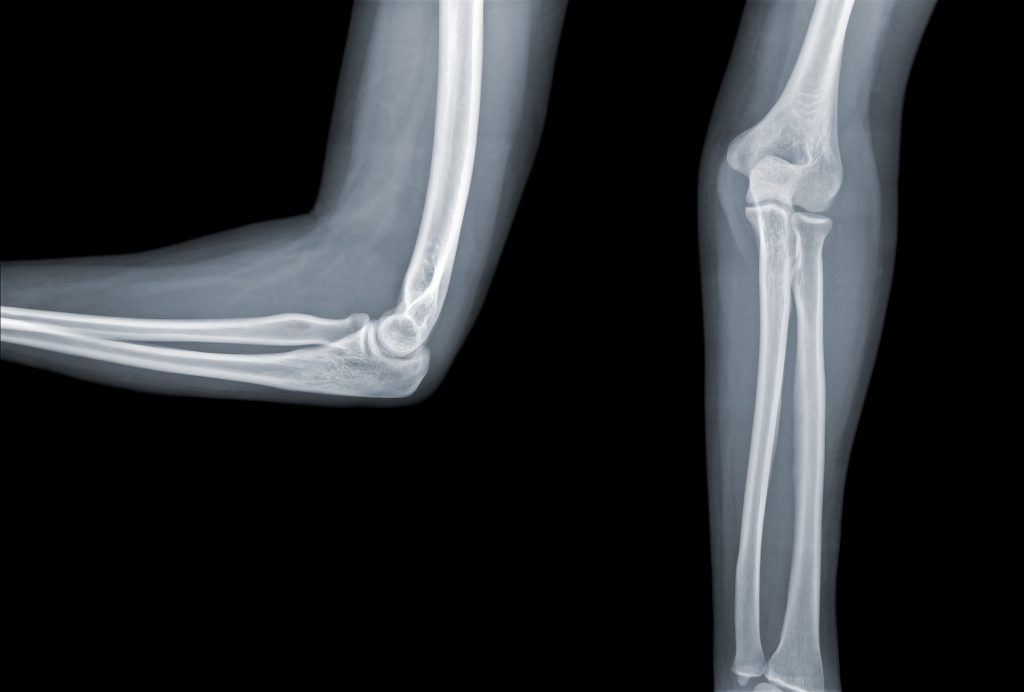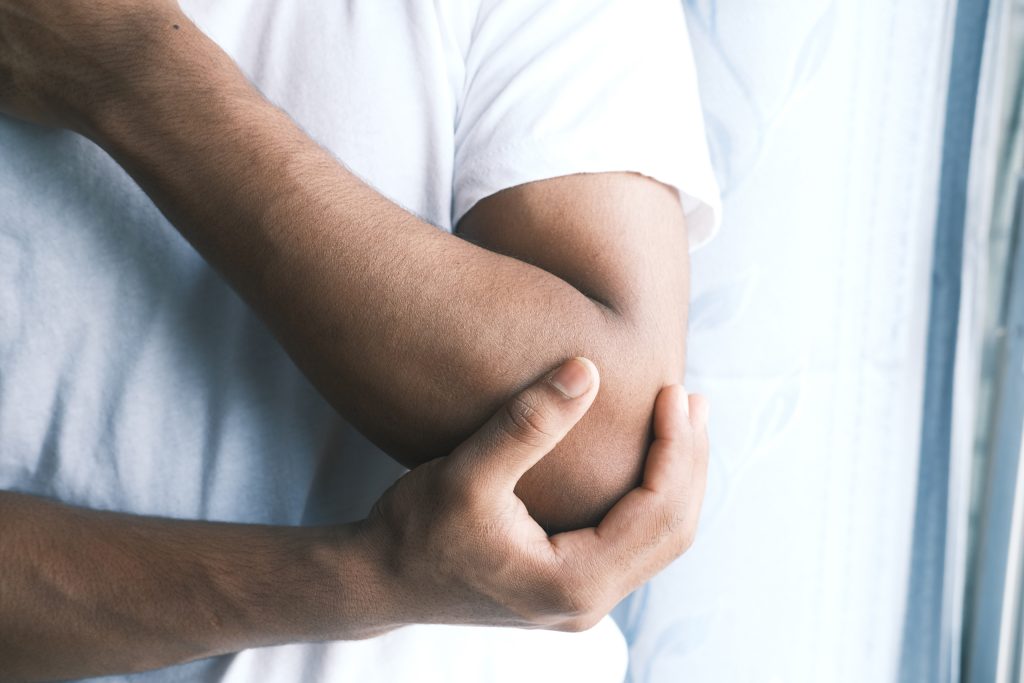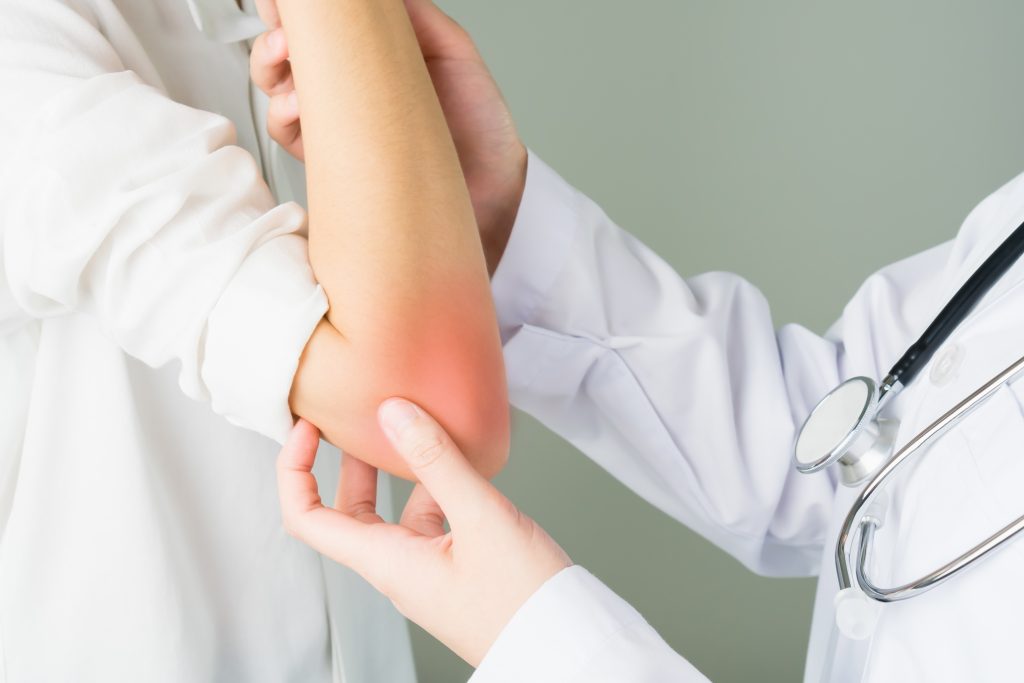Elbow stiffness
Treatment by elbow specialist from Vienna
Elbow stiffness, also known as limited mobility of the elbow joint, is a painful condition that can significantly affect arm functionality and quality of life. It occurs when the elbow joint loses its normal range of motion and becomes stiff. The causes of elbow stiffness can be many, including injury, diseases such as osteoarthritis or joint inflammation, and postoperative complications. Affected individuals complain of pain, limited mobility and difficulty with daily activities. Timely diagnosis and treatment are critical to restoring elbow mobility and minimizing subsequent problems. In this article, we will take a closer look at the causes, symptoms, diagnostic procedures and treatment options for elbow stiffness.
Anatomy of the elbow
The elbow is a complex joint consisting of three main components: the upper arm bone (humerus) and the two lower arm bones, the ulna (ulna) and the radius (radius). These three bones are connected by various ligaments, muscles and tendons to provide stability and mobility.
The humerus forms the upper part of the elbow joint. At its distal end, the part closest to the elbow joint, there is a bony prominence called the humeral epicondyle. Important attachment points for tendons that control the movement of the elbow are located here.

The elbow is a complex joint consisting of three main components: the upper arm bone (humerus) and the two lower arm bones, the ulna (ulna) and the radius (radius). These three bones are connected by various ligaments, muscles and tendons to provide stability and mobility.

The humerus forms the upper part of the elbow joint. At its distal end, the part closest to the elbow joint, there is a bony prominence called the humeral epicondyle. Important attachment points for tendons that control the movement of the elbow are located here.
The ulna and radius form the lower part of the elbow joint. The ulna is the larger of the two bones and is located on the inside of the forearm. The radius is located on the outside of the forearm and is slightly thinner than the ulna.
Between the humerus, ulna and radius are various ligaments that stabilize the joint. The ulnar collateral ligament and the radiocollateral ligament on the inside of the elbow keep the joint stable from the side. The ligamentum anulare radii, also called the annular ligament, holds the radius in place and allows it to rotate about the ulna.
The muscles and tendons around the elbow enable the movements of the joint. The biceps muscle on the front of the upper arm is responsible for bending the elbow, while the muscles on the back of the arm, such as the triceps, are responsible for extension. Other muscles in the forearm control the rotation of the forearm.
Main function of the elbow
The main function of the elbow is to bend and extend the arm. This allows us to grip, lift and manipulate our hands. In addition, the elbow joint also allows for rotation of the forearm, which allows us to rotate our palm up or down.
The complex anatomy of the elbow and the interaction of bones, ligaments, muscles and tendons allow a wide range of movements. Proper elbow function is essential for many everyday activities, whether lifting objects, writing, opening doors or playing sports that require the use of the arms.
Disruption or injury to the anatomical structures of the elbow can lead to limitations in mobility, pain, and other symptoms, such as is the case with elbow stiffness. Learn more about it below!
What is elbow stiffness?
Joint stiffness is a common complication after elbow injuries. We consider the elbow to be stiff if the extension deficit is greater than 30 degrees and the flexion deficit is greater than 25 degrees. In other words, when the patient has a range of motion smaller than 90 degrees and mobility is thus severely limited. This is especially problematic since the function of the joint is necessary for most daily activities. Only at a flexion of about 120 degrees can the patient comfortably reach his mouth, and only at an extension of about 30 degrees does the patient have no problems with hygiene, carrying loads and working over the head.

Causes of elbow stiffness
The elbow joint is very prone to posttraumatic stiffness. This is due to its shape, connection with muscle fibers (rather than tendons), predisposition to comminuted fractures (of the humerus or forearm), and due to the unique response of the anterior joint capsule to injury (in the form of thickening).
The cause of elbow stiffness can be divided into external and internal. The external ones include in particular stiffness of the joint capsule and the collateral ligaments. Internal causes include loss of articular cartilage, poorly healed fractures of the humerus or forearm, or free joint bodies. Most often, however, the diagnosis involves a combination of both causes.
Overview: Injuries to the elbow
Overview: Injuries to the elbow
Stiffness of the elbow joint can occur not only due to complex fractures (fracture of bones) after an accident, but also after relatively trivial injuries. Therefore, in the elbow more than in other localizations, we observe the basic rules of osteosynthesis – gentle surgery, anatomical reduction, stable osteosynthesis and, above all, timely rehabilitation. By this we mean the “seven-day rule”, i.e. we never immobilize the elbow joint for more than a week.

Joint stiffness - history and experience
Similar to the stiffness of the knee joint, for example, the stiffness of the elbow joint shows a clear reference to the French orthopedic school. As early as 1976, the Judet brothers described their original technique of arthrolysis of the elbow joint (a surgical treatment to restore mobility). In our experience, the more severe the trauma to the elbow, the more severe the elbow stiffness may develop. However, the range of motion of the arm may be limited even after a trivial elbow contusion or overuse of the elbow. After a simple elbow dislocation, the causes of subsequent movement restrictions are usually external (stiffness of the joint capsule, collateral ligaments or muscle). The most severe cases of elbow stiffness occur after dislocation fractures, when both external and internal causes of restricted motion are usually present.
Is there a relationship between elbow osteoarthritis and elbow stiffness?
Yes, there is a relationship between osteoarthritis and elbow stiffness. Osteoarthritis refers to a degenerative joint disease in which the cartilage covering the joint surfaces becomes worn and damaged. This leads to pain, inflammation and limited mobility of the affected joint.
In the case of the elbow, osteoarthritis can cause stiffness of the joint, which is called elbow stiffness. Wear and tear of the cartilage and associated inflammation can lead to changes in the joint, such as the growth of bone growths (osteophytes) or loss of normal joint fluid. These changes can lead to limited mobility and make the joint stiff.

Is there a relationship between elbow osteoarthritis and elbow stiffness?
Yes, there is a relationship between osteoarthritis and elbow stiffness. Osteoarthritis refers to a degenerative joint disease in which the cartilage covering the joint surfaces becomes worn and damaged. This leads to pain, inflammation and limited mobility of the affected joint.
In the case of the elbow, osteoarthritis can cause stiffness of the joint, which is called elbow stiffness. Wear and tear of the cartilage and associated inflammation can lead to changes in the joint, such as the growth of bone growths (osteophytes) or the loss of normal joint fluid. These changes can lead to limited mobility and make the joint stiff.

Treatment of elbow stiffness
Why surgical treatment?

The joint capsule of the elbow joint is so strong and hardens so quickly that the joint is not expected to improve in mobility even with very intensive physiotherapy a few weeks after an injury. The restriction of movement causes considerable discomfort to the patient as they are restricted and prevented from performing activities of daily living, recreational activities such as sports, or even self-care. Impaired mobility is also accompanied by a reduction in quality of life and sometimes a loss of independence.
With these problems, the affected patients come to us with a request to relieve them of their suffering. Treatment in the case is possible only surgically.
Arthrolysis as a common treatment method
Similarly, in our experience, the more pronounced the elbow stiffness, the more difficult it is to arthrolyze the joint. Simple fractures cause the least elbow stiffness and therefore the best course of arthrolysis (motion release). The most severe stiffness-related pain and limitation of motion and the most difficult treatments are observed after comminuted dislocation fractures of the elbow. These should be performed by a specialist who has already performed many treatments of the elbow.
Other surgical treatment options
Other surgical treatment options
There is a whole range of surgical treatments for arthrolysis of the elbow joint. In the case of a slight deficit in extension, we use the arthroscopic technique, in which we operate with the optics of only a few point accesses. In cases of moderate elbow stiffness, a lateral surgical approach to the joint is usually sufficient, where we usually find the main cause of the restricted movement. If the skin quality is poor, we use closed distraction arthrolysis on an external fixator. In cases of high severity of elbow stiffness, we have used an extended posterior surgical approach to the elbow joint for many years. All these methods are complex, pose a great challenge to the specialist and are successfully performed by very few highly specialized experts in orthopedics.

My experience with elbow stiffeners
I have been dealing with these complaints for more than a quarter of a century and have operated on many patients who have subsequently been able to return to their original activities. I have already had the privilege of publishing the results of my work in professional journals, presenting them at world conferences, and describing them in my professional books.
Other clinical pictures of the elbow
- Tennis elbow (epicondylitis humeri radialis)
- Golfer's elbow (Epicondylitis humeri ulnaris)
- Elbow ligament injury and elbow instability
- Bursitis (inflammation of the bursa)
- Elbow luxation (dislocation of the elbow joint)
- Elbow fracture (fracture of one or more elbow bones)
- Elbow arthrosis (degenerative changes of the articular cartilage in the elbow joint)
- u.v.m
I am your specialist for any complaints of the elbow! Contact me for an appointment in my office!